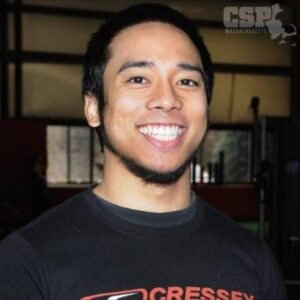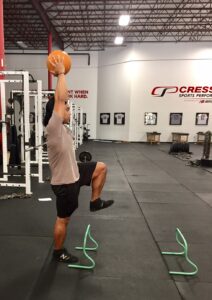
7 Random Thoughts on Plyometrics
Today’s guest article comes from Miguel Aragoncillo, one of the contributors on our Cressey Sports Performance Innovations resource. It’s on sale for $75 off through Sunday at midnight with coupon code APRIL2020 at www.CSPInnovations.com. Enjoy! -EC

My contribution to CSP Innovations was on the topic of post-activation potentiation (PAP), and you can’t talk about PAP without getting knee-deep in a discussion of plyometrics. That said, there were quite a few “spillover” thoughts on this front that I thought would complement my webinar nicely. Here they are:
1. Change the Environment to Improve Outcomes.
Based on what the athlete or individual needs in his or her sprinting capabilities, a different starting position can be used to help teach a different “lesson.” Whether it is drive in the first few yards, arm swing, or even learning how to manage torso position past 10 yards, there are different tools that can be utilized to improve your sprinting ability.
With sprinting (along with several other forms of plyometrics) the position of the set up will greatly affect the outcome of the exercise. As an example, if you begin a sprint with one knee on the ground, you will need to display greater initial strength in order to overcome gravity in comparison to a sprint that starts after shuffling for five yards.
Further, you can use small hurdles at 12 inches or so in order to elicit a higher knee position, or you may simply or kick the hurdles as you move forward.

Much like attacking your specific weaknesses in your strength training and lifting endeavors, the correct tool must be used at the correct time in order to deliver the most appropriate outcome of efficiency, and in this case, power and force development.
2. Change the Words We Use.
While the above point looks to improve upon the external environment in order to help your athletes and clients to move better, the next point aims to improve how your brain processes this information in order to also move better.
Using words in order to describe a movement, motion, or intention behind a movement are all ways we can alter the outcomes of a movement.
Essentially, you can alter the outcomes of a movement by utilizing two techniques: 1) change your words to reflect the intensity of a movement, and 2) provide an external task to be accomplished.
Using words like tap, boom, and zoom, or using claps, or stomps can help reinforce the concept of moving with intention and speed. The purpose of these words will help to improve the rate of force production, along with force absorption if certain awareness is needed when landing as you perform different drills.
3. Physically Demonstrate Exercises.
As a coach, I am always interested whenever someone presents a faster and more efficient way to coach one or more athletes. With this in mind, the point should be driven further that non-verbal cueing is one of the bigger ways to improve upon a movement pattern.
Sure, there are tons of ways for people to learn. Using all five senses is certainly a way to help improve the learning process, but using smell as a way to teach someone to jump may not be the best course of action.
Sometimes a bounding motion is difficult to describe verbally, but showing it will help demonstrate the movement pattern, and describing the emphasis on the desired “hang time” from leg to leg for the movement will reinforce the intention of staying on the ground as little as possible.
Follow up your demonstrations with one or two words (similar to what was described above) to reinforce your intentions and any small details that may not appear to the naked eye.
4. Improve Maximal Strength Before Looking to Improve Maximal Speed.
The off-season is a time to increase strength, as this is the foundation that can create greater speed for our athletes. At Cressey Sports Performance, we do not shy away from deadlifting or squatting the first week our athletes come back.
While the act of deadlifting may feel like a far cry away from increasing sprint time or even further removed from increasing baseball pitching velocity, the take-home message here is that the details found in lifting heavy will contribute to the whole and not take away from the movement pattern. In fact, improving total body maximal strength will eventually lead to a greater rate of force production, as force production is the name of the game when looking to increase speed for your athletes.
5. Using Overload May Not Be the Best Tool for Athletes.
While this may seem contradictory considering the last point, every athlete will respond differently to various percentages of maximal strength. Some athletes 90% of their 1RM relatively quickly, while others move that weight slowly. When speaking about force production, research from Stone et al. (among many others), saw 30% of 1RM maximal strength in lower body exercises as a “sweet spot” for power output with jumping exercises. Further, stronger athletes have greater abilities to express this force production quality.
From the Stone et al (2003):
“… The strong group had higher values at all percentages of 1RM when compared with the weak group. The strong group had their highest power outputs at 40% of 1RM; the weak group had decreasing power outputs as the percentage of 1RM increased.
“… These correlational findings suggest that jumping power may be increased with improvement of the 1RM squat. The fact that the 5 strongest subjects had markedly higher power outputs than the 5 weakest subjects strengthens this finding.”
In this same vein, when we begin to get more specific with our movement patterns, we will eventually need to express faster and faster motions, following the force velocity curve (or absolute strength to absolute speed continuum) as the off-season transitions to pre-season for our athletes!
6. Where the Head Goes, the Body Follows.
If your head, eyes, or other seemingly small detail is “off,” your ability to deliver a movement to its best potential will be thrown off. To this end, your set-up can affect the execution of your movement.
If you’re performing continuous jumps, try looking straight down, and see how you do. Then perform another set looking straight, and then looking up into the air. See what fits best for you and your athletes, and change it based on your drill. The eye and head position will change based on the focus of the drill.

Specifically, when you are looking to improve your distance in a movement such as bounding in a certain amount of jumps, or jumping to increase vertical force production, focusing on an object or space for your vision is the purpose when precision is the name of the game.
7. Competition can breed better output.
This isn’t so much a lesson in plyometrics, but a lesson in performing plyometrics based on your environment and possible training partners.
Perform a drill by yourself, and you can expect to get a certain result – whether it is up to standard is up for debate. Perform a drill in the presence of 10-15 teammates who are all motivating each other can create a better environment, and you can increase your results tenfold. This does not mean to crush your body to the point of no return and getting injured, but having a team or partner(s) to motivate you can improve your outcomes significantly.
How can this be put into action when you are trying to improve from a maximal speed drill? Next time you are in a training rut, see if you can find a few reliable training partners to hold yourself accountable. Challenge yourself or your friends to a few races at the end of a lifting session, whether it is with jumps, bounds, or chasing whoever is at the top of a leaderboard.
For more plyometric training strategies, be sure to check out Miguel’s presentation, “Post-Activation Potentiation: Mechanisms, Methods, and Results.” It’s available as part of our resource, CSP Innovations. Visit www.CSPInnovations.com to learn more – and enter coupon code APRIL2020 to get $75 off.
About the Author
You can follow strength and conditioning coach Miguel Aragoncillo on Twitter at @MiggsyBogues, and more of his writing can be found on www.MiguelAragoncillo.com.




